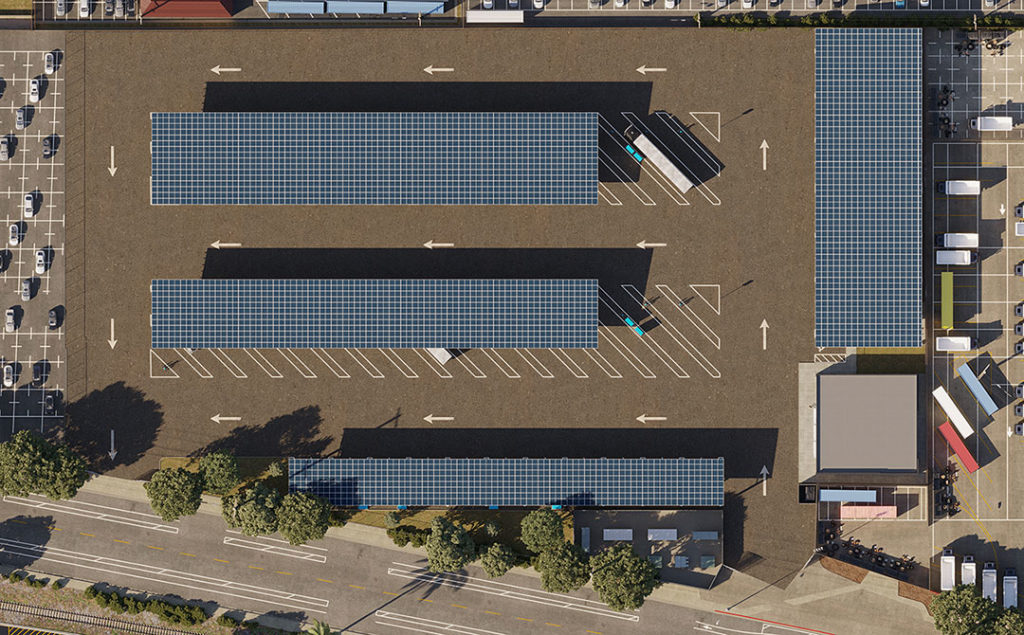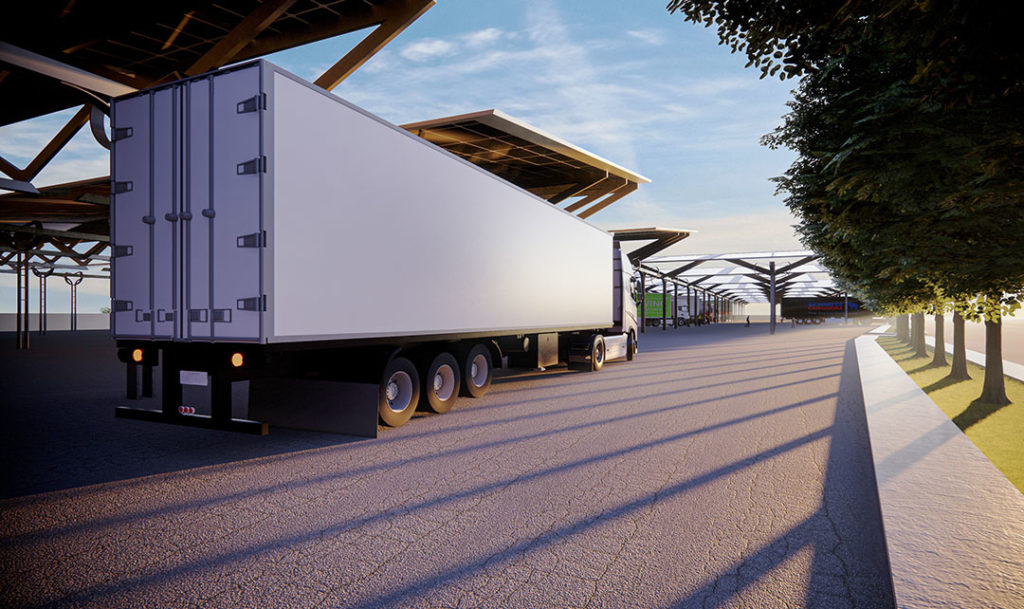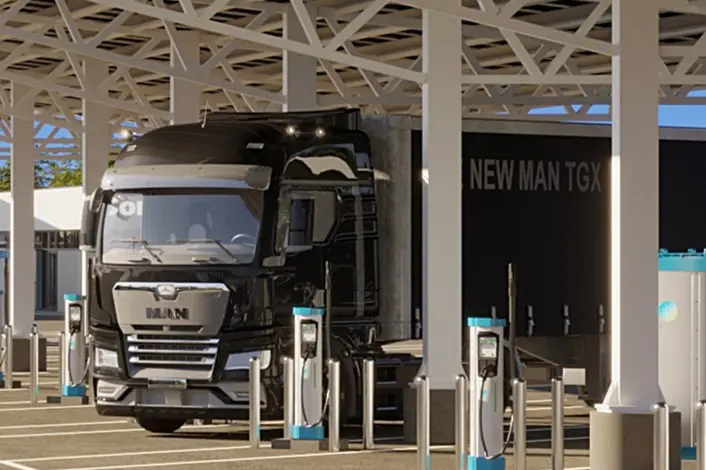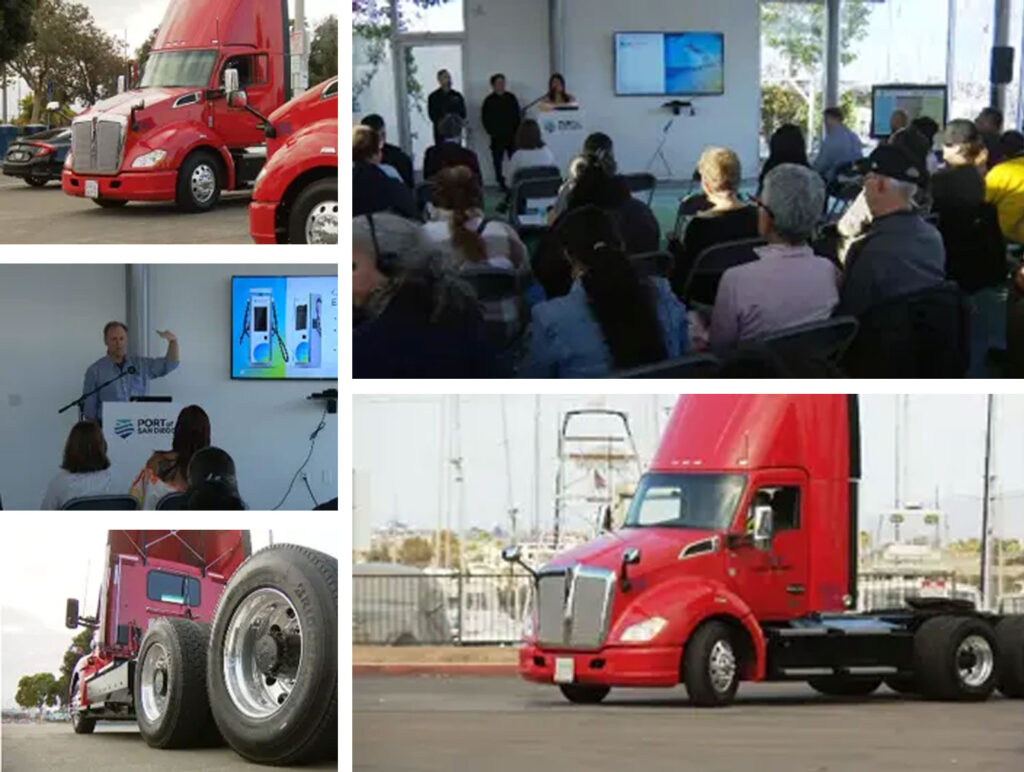Tidelands Avenue Electric Truck Hub
Servicing Medium- and Heavy-Duty Electric Trucks for Cleaner Air, Stronger Communities
Community engagement is an ongoing process, and we are committed to gathering feedback and sharing updates regularly. As we continue to work with local stakeholders, this site will be progressively updated with the latest information and developments to ensure transparency and open communication.
Project Summary
The Skycharger eHub is a first-of-its-kind electric truck charging station located in National City on Tidelands Avenue. It’s designed to accelerate California’s clean freight transition by enabling widespread adoption of electric medium- and heavy-duty trucks—while also supporting port operations, regional air quality, economic opportunity, and environmental justice.
This flagship project aligns with the Port of San Diego’s Maritime Clean Air Strategy and introduces Skycharger’s innovative Trucking-as-a-Service (TaaS) model, making fleet electrification easier, more affordable, and accessible to all.

What’s Included
- Up to 70 medium- and heavy-duty electric trucks charged simultaneously
- 24/7 secure, well-lit charging and parking, including secure overnight parking for 46 trucks
- Amazon Just Walk Out® Convenience Store
- 1.7 MW on-site solar canopy and up to 2MW battery energy storage system for grid resiliency, energy independence, and reduced reliance on peak grid power
- Solar and battery systems are fully compliant with national fire protection standards (NFPS), safety codes, third-party certifications, and guidance from the National City Fire Department
- Public green space and shaded picnic areas
- Secure fencing, lighting, landscaping, and on-site staff

Community Benefits
This project is about more than electrifying trucks — it’s about improving quality of life in National City and surrounding portside neighborhoods. Cleaner air, local jobs, educational investment, and green space are just the start.
Community investments include:
- Hiring local labor for construction and operations
- Workforce training in solar, electrical, and EV technologies
- Creation of a community fund in collaboration with local stakeholders to support grassroots initiatives, education, and neighborhood projects on an annual basis
Environmental + health benefits:
- Cleaner air
- Reduced diesel emissions
- Lower noise pollution
- Added green space and public amenities
Trucking-as-a-Service
Electrifying a fleet can feel overwhelming. Skycharger’s Trucking-as-a-Service (TaaS) program removes those barriers and makes zero-emission trucking accessible, reliable, and scalable.
The TaaS program includes:
- A fully charged, operational electric truck ready each day
- No technology risk — we maintain and manage it
- No credit risk — we backstop financing
- A clear, affordable path to ownership
- Turnkey solutions for charging, energy, and logistics

Planning for Safety
Safety is integrated into every aspect of the project — from design and engineering to emergency response planning.
Key Planning Elements:
- Active collaboration and planning with the National City Fire Department
- Emergency Response Plan developed in partnership with Burns & McDonnell
- Engagement with third-party experts in solar and battery safety best practices
- Fire code compliance and safety testing aligned with NFPA (National Fire Protection Association) standards
On-site security:
- Controlled access, surveillance, and round-the-clock lighting
- On-site staff and support during most hours of operation
Safety for truckers, neighbors, and first responders is a top priority — and will remain central as this project moves forward.
In the News & Around the Community
The Tidelands Avenue Electric Truck Hub project is already making an impact. From community events to local media coverage, here’s a look at how the region is engaging with the future of clean freight:
Voice of Sand Diego – South County Report: South County Report: Keep On (Electric) Truckin’
San Diego Union Tribune: Developer proposing zero-emission, truck-charging hub in National City to host community meeting
San Diego Daily Transcript: Port planning electric truck charging hub in National City
San Diego Business Journal: National City EV Truck Charging Station Electrifies Port
Have your own photos or thoughts from the event? We’d love to see them — email us at zevtruckhub@skycharger.com.

Inquiry Form
Stay Informed
Enter your email to get the latest updates.
Frequently Asked Questions
1. Environmental Impact
A: This project will improve local air quality, lower traffic noise, create some small green space, and have minimal light pollution.
A: Switching the truck fleet serving the port from diesel to electric will improve air quality both at the port and in surrounding communities, particularly those directly downwind, including residents of National City. Diesel trucks emit harmful pollutants like nitrogen oxides and particulate matter, while electric trucks produce no emissions. The more trucks that transition to electric, the cleaner the air will be.
A: Electric trucks are quieter than diesel trucks, with a typical electric truck, producing approximately 33% less noise. An increase of just a few decibels can be perceived as twice as loud.
A: No, the project will actually add green space. The site is currently fully paved, and the design includes a section of green space as well as an outdoor picnic area.
A: The truck stop will be well-lit with energy-efficient, downward-facing LED lights located beneath a solar canopy. The amount of light emitted from the site will be less than that of a typical streetlight.
2. Traffic and Infrastructure
A: The eHub is located on Tidelands Ave., along an existing port-serving truck route. The project is designed to primarily serve existing truck traffic, where diesel trucks are replaced by electric trucks. Trucks that charge overnight will remain on Port property, rather than being driven home through residential neighborhoods.
The project will collaborate with traffic engineers and local authorities to implement road safety measures, including improved signage and pedestrian safety features. The eHub will feature dedicated entry and exit points for easy access.
A: Federal law limits the maximum weight of trucks to 80,000 pounds for heavy-duty trucks. So while the tractor portion of a truck is heavier than diesel trucks, the total weight including payload (freight) is the same. Studies show that electric trucks do not cause significant additional road wear. University of California Institute of Transportation Studies
A: The electric truck charging hub will accommodate 46 trucks overnight and features 24 charging ports available for use 24/7.
A: Utilization is expected to ramp up over time as more electric trucks are adopted.
3. Aesthetic and Property Value Concerns
A: The project is expected to enhance property values for surrounding businesses and local communities due to cleaner air. Skycharger will invest millions to transform the current open parking lot on Tidelands Avenue—currently surrounded by industrial buildings and featuring a chain-link fence—into a clean, well-lit truck stop and convenience store. This new development will incorporate landscaping, green space and picnic tables, creating a safe and inviting environment.
EV infrastructure is viewed as a positive development that reflects a forward-thinking, sustainable community. Studies indicate that areas embracing green technology and cleaner energy tend to see improved property values over time. University of Maryland School of Public Policy Study
4. Social and Economic Impact
A: Creating new jobs: The EV truck hub will create dozens of new, well-paying jobs during construction and for ongoing operations. This includes roles in project construction, solar and battery storage management, charging station maintenance, and retail operations.
Increased revenue for National City: National City will benefit from increased revenue through sales and property taxes, as well as a one-time permit fee. This financial support will enhance the city’s budget and local services.
Community benefits – We hire local: Skycharger and its partners are committed to hiring local labor for the project. Skycharger will partner with San Diego area job training programs and apprenticeship programs that include training in electrical work, solar technology, battery storage, and electric vehicle charging. Additionally, the company will contribute to a local fund to support local causes in neighboring communities.
5. Public Health and Safety
A: Replacing diesel trucks with electric trucks will reduce greenhouse gas emissions, and eliminate emissions of dangerous, dirty diesel pollutants such as PM 2.5 and Nox. This will significantly improve air quality, improving the health of portside communities.
A: The installation of solar and battery systems is highly regulated. Recent battery storage fires in Southern California have raised safety concerns, particularly regarding lithium-ion batteries. Skycharger is working closely with the National City fire department and the project team to deploy state-of-the-art safety practices. Further, evolving battery technology makes it less likely for a fire to start, and the size of the battery installation is miniscule compared to other project sites that experienced fires using older technology.
A: There are two types of batteries becoming more common in communities: electric vehicles, which function as mobile batteries, and stationary battery storage systems. In California, there are 2 million registered battery electric vehicles and nearly 200,000 stationary batteries installed.
In National City, over 1,500 battery electric vehicles are registered. As of September 1, 2024, there are more than 190 stationary batteries in the area, including battery electric storage systems at 13 commercial sites and one utility-scale installation. The remainder of the installations are located in residential properties.
A: Skycharger is developing an emergency response plan together with engineering firm Burns & McDonnell, and the National City Fire Department.
A: The site will be fenced and well-lit, equipped with security cameras throughout. Additionally, there will be employees on-site nearly all the time to ensure safety.
6. Energy Consumption and Resources
A: The project has been carefully planned in collaboration with San Diego Gas and Electric, which will be able to supply the necessary power. Skycharger is also adding solar and battery electric storage systems to reduce dependency on the grid and provide power to the trucks during peak load times.
A: Yes, power will be generated on-site and use a battery energy storage system, prioritizing this self-generated power. Any additional power needed will come from SDG&E. California’s significant investments in solar and wind power generation mean it has some of the cleanest energy in the nation.
7. Community Involvement and Transparency
A: Skycharger is committed to keeping the community informed and involved at every stage of this project. Skycharger will provide regular updates on this page to ensure transparency and address any concerns residents may have. You can sign up on the form on this page to receive notices of upcoming meetings and project updates.
